The Essential Foundation of Modern Mortuary Preparation
An embalming table is a specialized piece of mortuary equipment designed to support a deceased body during preparation procedures, featuring drainage systems, adjustable height mechanisms, and durable materials for sanitation and fluid management.
| Key Embalming Table Facts | Description |
|---|---|
| Primary Purpose | Supports body during embalming, preparation, and dressing |
| Standard Materials | 304 stainless steel with grained finish and matched welds |
| Common Dimensions | 32"×80" to 35"×85" with 3" slope for drainage |
| Weight Capacity | 600-1,000 lbs depending on model |
| Price Range | $1,095 (folding) to $5,194 (hydraulic) |
| Types | Hydraulic, folding, multi-height, bariatric, ventilated |
The embalming table stands as the centerpiece of any funeral home preparation room, providing a stable, sanitary surface for all aspects of post-mortem care. Beyond its basic function, a quality table improves workflow efficiency, reduces physical strain on embalmers, and ensures proper drainage of bodily fluids and preparation chemicals. Modern tables come in various configurations to accommodate different facility needs, space constraints, and budget considerations.
Selecting the right embalming table involves understanding the balance between durability, functionality, and cost. The material construction—typically 304 stainless steel—ensures longevity and easy cleaning, while features like hydraulic height adjustment (30"-38") provide ergonomic benefits for preparation staff. Many tables include casters with locking mechanisms for mobility when needed and stability during procedures.
My name is Mortuary Cooler, and as a national-level supplier of mortuary equipment including embalming tables, I've helped hundreds of funeral directors select and configure preparation rooms with the right embalming table solutions for their specific operational needs. My experience has shown that the right embalming table can dramatically improve both workflow efficiency and preparation quality.
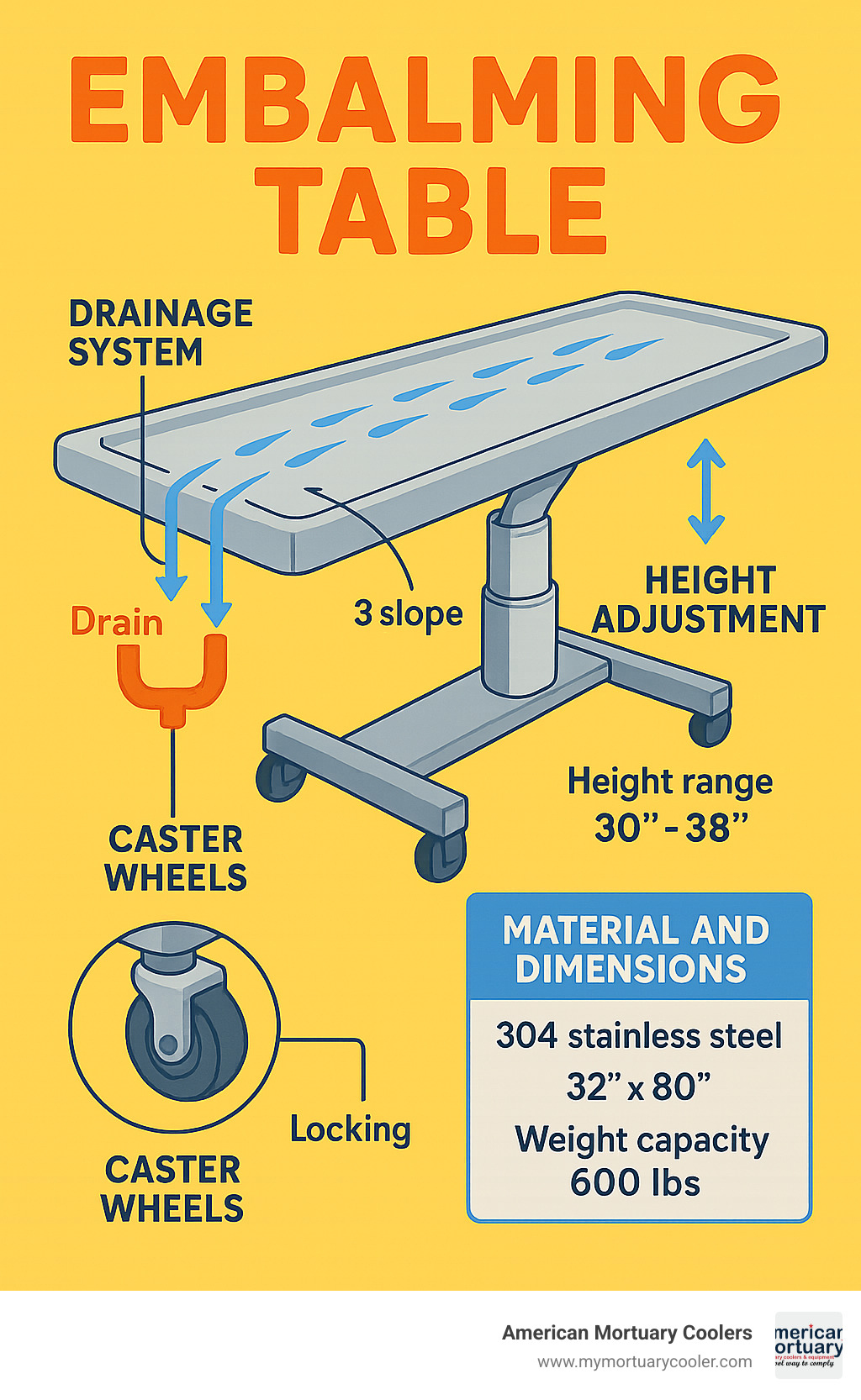
Embalming table definitions:
Why This Guide Matters
For mortuary professionals, an embalming table is not just a piece of equipment—it's the foundation of their daily work. Making an informed decision about which table to purchase can have lasting impacts on:
- Staff comfort and reduced physical strain during long preparation procedures
- Workflow efficiency and case turnaround time
- Longevity of equipment and return on investment
- Compliance with industry standards and regulations
- Overall quality of preparation services
With prices ranging from just over $1,000 for basic models to more than $5,000 for advanced systems, selecting the right embalming table represents a significant investment for any funeral establishment. This guide aims to provide comprehensive information to help mortuary professionals make confident, informed decisions when comparing and selecting embalming tables.
What Is an Embalming Table?
An embalming table is more than just a surface—it's the heart of every preparation room. Think of it as a specialized workstation carefully designed to support the deceased during embalming and other preparation procedures. Its purpose extends far beyond simply holding a body; it's an essential tool that facilitates the entire embalming workflow from start to finish.
What makes an embalming table unique is its built-in drainage slope—typically around 3 inches (5 cm)—which ensures that fluids naturally flow away from the body toward a drain. This seemingly small but crucial design feature is intentionally engineered into quality tables, as industry specifications often note: "The table has a permanent 3 in. (5 cm) slope to assist in drainage."
Core Functions and Workflow Benefits
When I visit funeral homes across the country, from small family operations in rural Tennessee to large establishments in metropolitan areas like Chicago, I see how the right embalming table transforms their daily work.
Good tables provide ergonomic positioning with height adjustments ranging from 30" to 38", allowing embalmers of different heights to work comfortably without back strain. This is especially important during lengthy procedures where poor posture can lead to chronic pain.
Most quality tables include 6" or 8" locking swivel casters—a feature that might seem minor but makes a world of difference. These allow staff to easily move the table around the prep room when needed, then lock it securely in place during procedures.
The tilting ends found on premium models are invaluable for proper body positioning during different stages of the embalming process. This adjustability helps achieve better results while reducing physical strain on the embalmer.
At American Mortuary Coolers, we've found that funeral homes across our service areas—from New York to Los Angeles—benefit most from tables that match their specific workflow needs and case volume.
More info about embalming tables
How an Embalming Table Streamlines Prep
A well-designed embalming table makes preparation procedures smoother, safer, and more efficient in several key ways.
The slight elevation and tilt capabilities allow embalmers to position the deceased for optimal access to arterial injection points. This isn't just about convenience—it's crucial for achieving even distribution of embalming fluids throughout the body, which directly impacts the quality of preservation.
Many of our customers love the roller loading systems incorporated into modern tables. As one preparation room manager from our Southeast Region shared with me: "The roller system cut our transfer time in half and significantly reduced staff injuries from lifting." These rollers at one end of the table make transferring bodies from cots or stretchers much easier, protecting both the deceased and the funeral home staff.
Embalming tables also contribute significantly to caregiver safety. The physical demands of funeral service work are often overlooked, but the right equipment makes all the difference. By providing a stable, properly-positioned work surface at the right height, quality tables reduce the physical strain on embalmers. This means fewer sick days, longer careers, and better overall health for the professionals who provide this essential service.
The 3-inch slope and integrated drainage systems ensure that fluids are directed away from the work area, creating a cleaner, safer environment. During arterial injection, when significant volumes of fluids need to be managed, this thoughtful design feature proves its worth every day in prep rooms across America.
Major Types of Embalming Tables
The funeral industry offers several distinct types of embalming tables, each designed to address specific needs, space constraints, and budgetary considerations. Understanding the differences between these types is crucial for making an informed purchase decision.
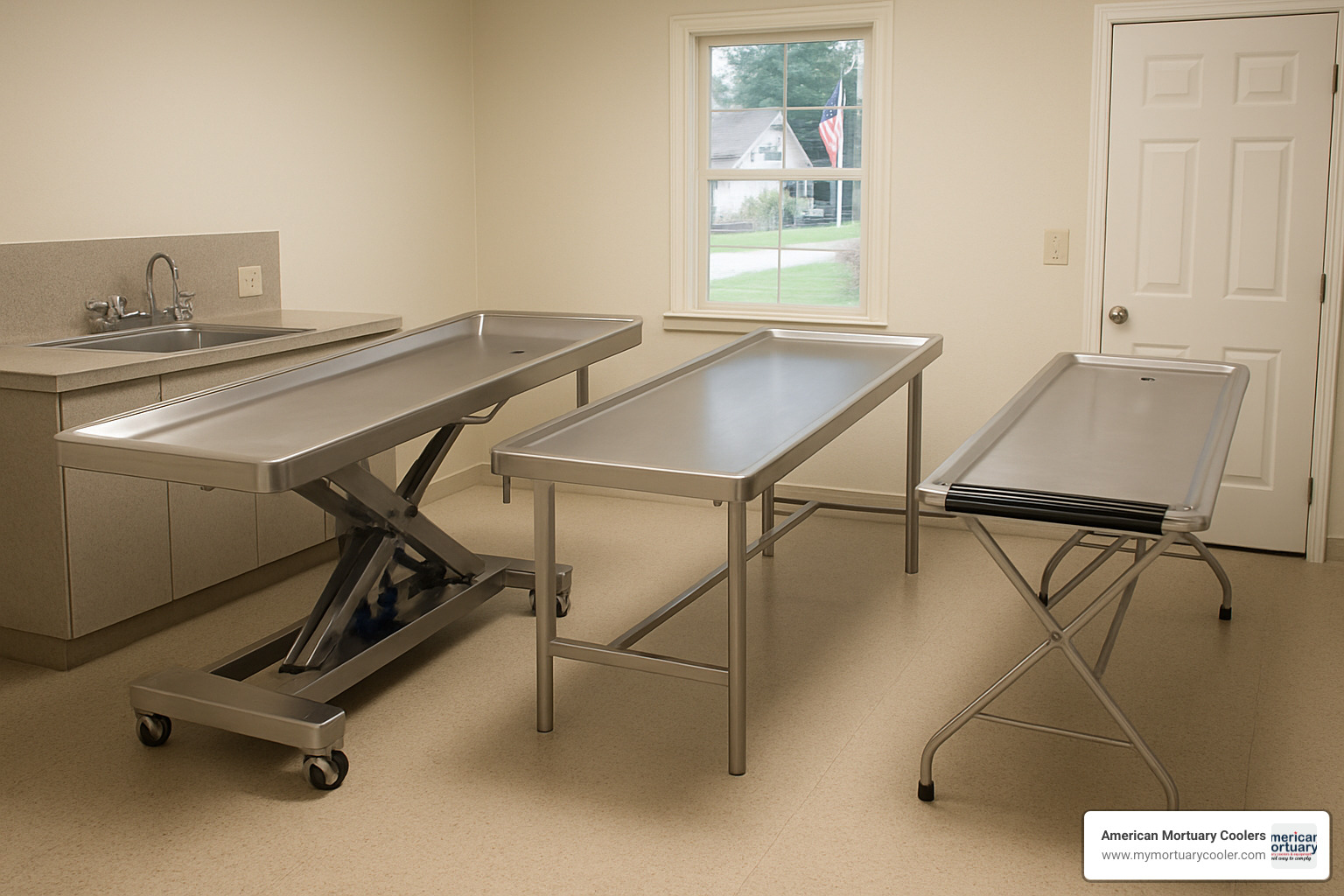
Hydraulic Models
Hydraulic embalming tables represent the premium tier of preparation equipment, offering superior adjustability and ergonomics. These tables feature hydraulic lift mechanisms that allow for precise height adjustment, typically between 30" and 38", to accommodate embalmers of different heights and various preparation procedures.
The beauty of hydraulic models lies in their versatility. Whether powered by a foot pump that lets you adjust height with a simple pumping motion, or an electric lift that does the work at the touch of a button, these tables make life easier for preparation staff. Most hydraulic models support between 600-650 lbs, though heavy-duty versions can handle up to 1,000 lbs without breaking a sweat.
One funeral director from our Pittsburgh service area recently told me, "Investing in a hydraulic table was the best decision we made for our prep room. The staff immediately noticed less back strain, and we've been able to accommodate embalmers of various heights much more comfortably."
These quality tables aren't cheap—expect to invest between $2,885 to $5,194 depending on features and brand—but the ergonomic benefits and staff satisfaction make them worth every penny for busy preparation rooms.
Folding & Dressing Tables
Folding embalming tables offer a wonderful blend of versatility and space efficiency. They're the Swiss Army knife of the preparation room—perfect for smaller facilities or as secondary tables when you need extra workspace.
These lightweight champions can be quickly set up when needed and folded away for storage, providing flexibility that fixed tables simply can't match. Starting at approximately $1,095, they're also the most budget-friendly option for funeral homes watching their bottom line.
I've noticed folding tables are particularly popular with our customers in the Midwest, especially in rural funeral homes that handle variable case volumes. They're perfect for those situations where you might need to create a temporary preparation area or perform off-site embalming. When space is at a premium, these tables really shine.
More info about folding mortuary tables
Multi-Height & Combination Units
Multi-height embalming tables strike a perfect balance between fixed and fully hydraulic models. Think of them as the "just right" option for many funeral homes—they provide height adjustability through mechanical means rather than hydraulics, offering ergonomic benefits at a more accessible price point.
What makes these tables special is their versatility. Many models feature dual tilt ends, allowing independent adjustment of both head and foot sections. This makes them suitable for embalming, dressing, and sometimes even autopsy procedures—truly a jack-of-all-trades in the preparation room.
These tables have become increasingly popular with our Northeast customers, where space efficiency and multi-functionality are highly valued in older funeral establishments with cozy prep room dimensions. Priced typically between $1,800 to $3,000, they hit that sweet spot in the mid-range market segment.
They're also favorites in mortuary science programs where instructors need to ensure all students can clearly see demonstration techniques—the adjustable height makes visibility a non-issue regardless of classroom setup.
Bariatric & Oversized Tables
With America's changing demographics, bariatric embalming tables have become an essential option for forward-thinking funeral homes. These reinforced tables feature wider surfaces (typically 35"×85" compared to standard 32"×80") and significantly higher weight capacities of 1,000 lbs or more.
The construction of these tables doesn't cut corners—they use heavier gauge stainless steel and additional structural support to ensure stability and safety. Yes, you'll pay a premium (generally 15-25% more than standard models), but the peace of mind is priceless.
A funeral director from our Dallas location put it perfectly: "Having a bariatric option has become non-negotiable in today's market. We use our standard table for most cases, but having the bariatric table available has prevented numerous difficult situations."
For many funeral homes, a bariatric table isn't about handling frequent oversized cases—it's about being prepared for those special situations where having the right equipment makes all the difference for the family's experience and your staff's safety.
Autopsy-Specific & Ventilated Tables
Specialized embalming tables designed for autopsy procedures or improved ventilation take preparation capabilities to the next level. These tables shine in funeral homes that perform autopsies or handle special cases requiring superior fluid and air management.
The standout feature on these models is often the downdraft exhaust system with side perforated connections that integrate with your ventilation system. Combined with improved drainage (typically featuring a 3" trough with larger drain stems) and perforated surfaces that allow for better fluid drainage and air circulation, these tables create a cleaner, more efficient working environment.
We've seen particular demand for these specialized tables in our Los Angeles and New York service areas, where medical examiner cases and specialized preparations are more common. The additional sealing to prevent fluid infiltration makes these tables particularly valuable in challenging preparation scenarios.
The standard body tray is designed as an integral part of the embalming process and for cadaver handling. Equipped with rollers that allow for easy loading and unloading of cadavers, a 3in/5cm permanent slope designed to assist in drainage, and fabricated from square, 304 stainless steel tubing 1.5 in./3 cm., .12 in. thickness—it's built to handle the most demanding preparation needs.
Key Features, Specs, and Materials to Compare
When evaluating embalming tables, understanding the technical specifications and material differences is crucial for making an informed decision. Here, we break down the most important aspects to compare.
Materials & Build Quality
The material construction of an embalming table directly impacts its durability, sanitation properties, and longevity. The industry standard is 304 stainless steel, known for its excellent corrosion resistance even with frequent exposure to chemicals and bodily fluids.
Key Material Considerations:
- 304 Stainless Steel: The gold standard for embalming tables, offering superior corrosion resistance and durability.
- 14-Gauge Tops: Provides the optimal balance between strength and weight.
- Seamless Welds: Quality tables feature matched welds that prevent fluid infiltration and bacterial growth.
- Plastic Bases: Some models incorporate high-density plastic components for cost reduction and weight savings.
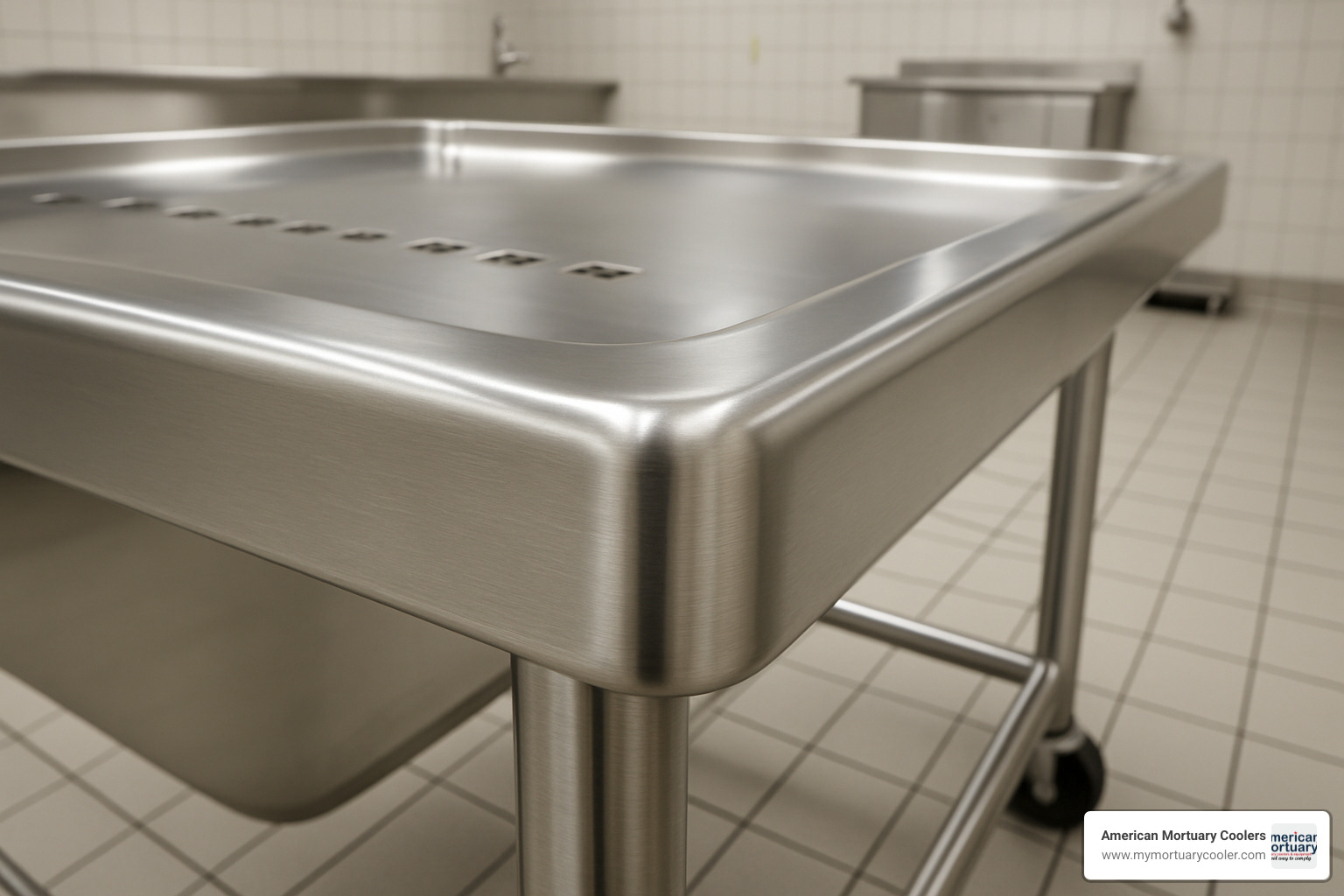
At American Mortuary Coolers, we've found that tables with properly finished welds and corners last significantly longer in the challenging prep room environment. As one of our technicians from the Rocky Mountain Region explains: "The difference between a good and great embalming table often comes down to the quality of the welds and finishing details that prevent corrosion at junction points."
Size, Weight Capacity & Ergonomics
The dimensions and ergonomic features of an embalming table significantly impact both the comfort of the embalmer and the ability to accommodate various body types.
Standard Specifications:
- Table Top Dimensions: Standard sizes range from 32"×80" to 35"×85"
- Weight Capacity: Typically 600-650 lbs for standard models, up to 1,000 lbs for bariatric versions
- Height Ranges: Adjustable models offer height settings from 30" to 38"
- Operator Ergonomics: Proper height adjustment reduces back strain during lengthy procedures
Our customers in the Southwest Region have particularly noted the importance of proper height adjustment, with one funeral director sharing: "Having a table that adjusts to the right height for each embalmer has reduced our staff complaints about back pain by about 80%."
Drainage, Fluid & Ventilation Systems
Perhaps the most critical functional aspect of any embalming table is its fluid management system. Effective drainage ensures a cleaner, more sanitary working environment and more efficient procedures.
Key Drainage Features:
- 3" Trough: Industry standard for directing fluids toward the drain
- 6" Drain Stem: Provides sufficient clearance for proper drainage connections
- Quick-Connect Rinse: Many models include integrated rinse systems for cleaning
- GFCI Outlets: Electrical connections should include ground fault protection for safety
The drainage slope is a crucial design element, with most quality tables incorporating a permanent 3-inch (5 cm) slope to ensure continuous fluid movement toward the drain. This seemingly small detail makes a significant difference in daily operation.
| Feature | Standard Table | Ventilated Table | Bariatric Table |
|---|---|---|---|
| Top Dimensions | 32"×80" | 32"×80" | 35"×85" |
| Weight Capacity | 600 lbs | 600 lbs | 1,000 lbs |
| Material | 304 SS | 304 SS | 304 SS (heavier gauge) |
| Drainage | 3" slope, 6" stem | 3" slope, 6" stem | 3" slope, 6" stem |
| Ventilation | None | Perforated sides | None |
| Height Adjustment | Fixed or 30"-38" | Fixed or 30"-38" | Fixed or 30"-38" |
| Price Range | $1,095-$3,500 | $3,500-$5,194 | $3,200-$5,000 |
Popular Accessories & Add-Ons
A basic embalming table can be improved with various accessories that improve functionality and workflow efficiency. These add-ons can significantly improve the utility of your table.
Common Accessories:
- Body Positioners: Help maintain proper positioning during procedures
- Head Rests: Provide stable support for head and neck positioning
- Tray Rinses: Integrated water systems for cleaning the table surface
- Side Extensions: Expand the width of standard tables when needed
- Ventilation Connectors: Allow integration with downdraft ventilation systems
In our Columbia, SC location, funeral homes frequently request side extension panels to occasionally accommodate larger individuals without investing in a full bariatric table. These practical add-ons can extend the versatility of a standard table at a fraction of the cost of a specialized model.
More info about embalming tables for funeral professionals
Safety, Sanitation, and Fluid Management
Safety and sanitation are paramount considerations when selecting and using an embalming table. Proper fluid management not only improves the working environment but also ensures compliance with health regulations.
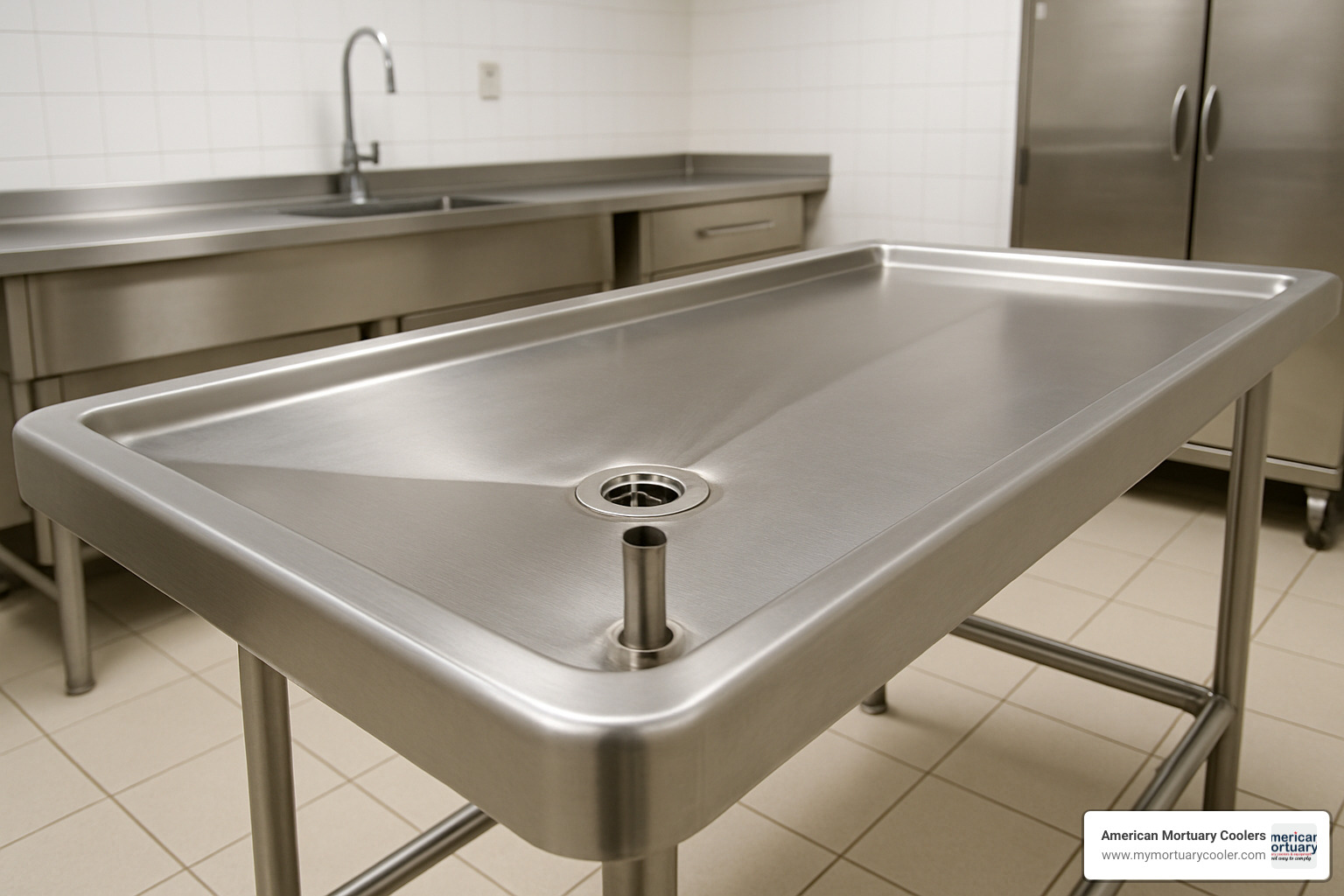
When I visit funeral homes across the country, I'm always struck by how the best-run preparation rooms have a common feature – meticulous attention to their embalming table maintenance. This isn't just about appearances; it's about creating a workspace that meets OSHA standards, protects staff health, and honors the deceased in your care.
The modern embalming table incorporates numerous safety features that weren't available even a decade ago. Antimicrobial surfaces resist bacterial growth between cleanings. Lockable wheels prevent unexpected movement during procedures. And advanced spill control features – like the 3-inch drainage slope and perimeter troughs – keep potentially hazardous fluids contained and directed toward proper disposal systems.
"The drainage system on our new table has been a game-changer," shared a funeral director from our Nashville service area. "We used to spend so much time managing fluid cleanup, but now everything flows exactly where it should. It's made our prep room a much safer place to work."
Cleaning & Maintenance Protocols
Maintaining an embalming table properly ensures both equipment longevity and staff health. A well-maintained table will provide years of reliable service while minimizing infection risks.
After each use, your embalming table should be thoroughly rinsed with water and a mild germicidal detergent. This immediate cleaning prevents bodily fluids and chemicals from drying on the surface, which makes them much harder to remove later. Daily cleaning should include checking drain stems for blockages – a simple step that prevents major headaches down the road.
On a weekly basis, take a moment to inspect the casters and locking mechanisms. These moving parts are easy to overlook but critical for safety. Monthly lubrication of moving parts on hydraulic or adjustable models keeps them operating smoothly, while a quarterly inspection of all welds and joints helps catch potential issues before they become problems.
I love the simple but effective approach one of our Atlanta customers developed: "We use a three-color magnetic tag system on our prep room door that rotates weekly, monthly, and quarterly to remind staff of different maintenance tasks. It's simple but extremely effective."
When selecting cleaning products, balance effectiveness against pathogens with gentleness on stainless steel. Harsh chemicals might disinfect well but can damage your embalming table over time. Similarly, abrasive cleaners or pads create tiny scratches that become hiding places for bacteria. A quality germicidal detergent specifically formulated for mortuary equipment offers the best of both worlds.
4 Tips to Perform Embalming Successfully
Religious & Cultural Considerations
America's diverse communities bring varied traditions to end-of-life care, and your embalming table selection should reflect these needs. At American Mortuary Coolers, we've helped funeral homes across all our service regions accommodate these important differences.
Muslim traditions often require tables that facilitate ritual washing (ghusl) with minimal handling of the deceased. Some of our customers serving Muslim communities have invested in specialized embalming tables with improved rinse systems specifically designed for this purpose.
For funeral homes serving Orthodox Jewish communities, tables that support shemira (watching over the deceased) and tahara (purification) make these sacred rituals more dignified. Bahá'í customs might require tables accommodating specific body preparation requirements, while Hindu traditions often involve family participation, necessitating tables with adequate surrounding space.
A funeral director from our Chicago location put it perfectly: "Having a table specifically designed for Muslim preparations has allowed us to better serve our increasingly diverse community. Families appreciate that we've invested in equipment that respects their traditions."
Some families may request minimal intervention preparations or "green" options. For these cases, an embalming table with excellent rinse-only capabilities and natural drainage becomes particularly valuable. The versatility to accommodate both traditional embalming and alternative preparation methods is increasingly important in today's market.
By considering these cultural and religious needs when selecting your embalming table, you position your funeral home to serve your entire community with respect and dignity – something that resonates deeply with families during their most vulnerable moments.
Pricing, Brands, and How to Choose the Right Embalming Table
Shopping for an embalming table can feel overwhelming with so many options and price points. I've helped hundreds of funeral directors steer this decision, and I've found that understanding the price range—from about $1,095 for basic folding models to $5,194 for advanced hydraulic systems—makes the process much easier. Let's break down what you're actually paying for at each price point.
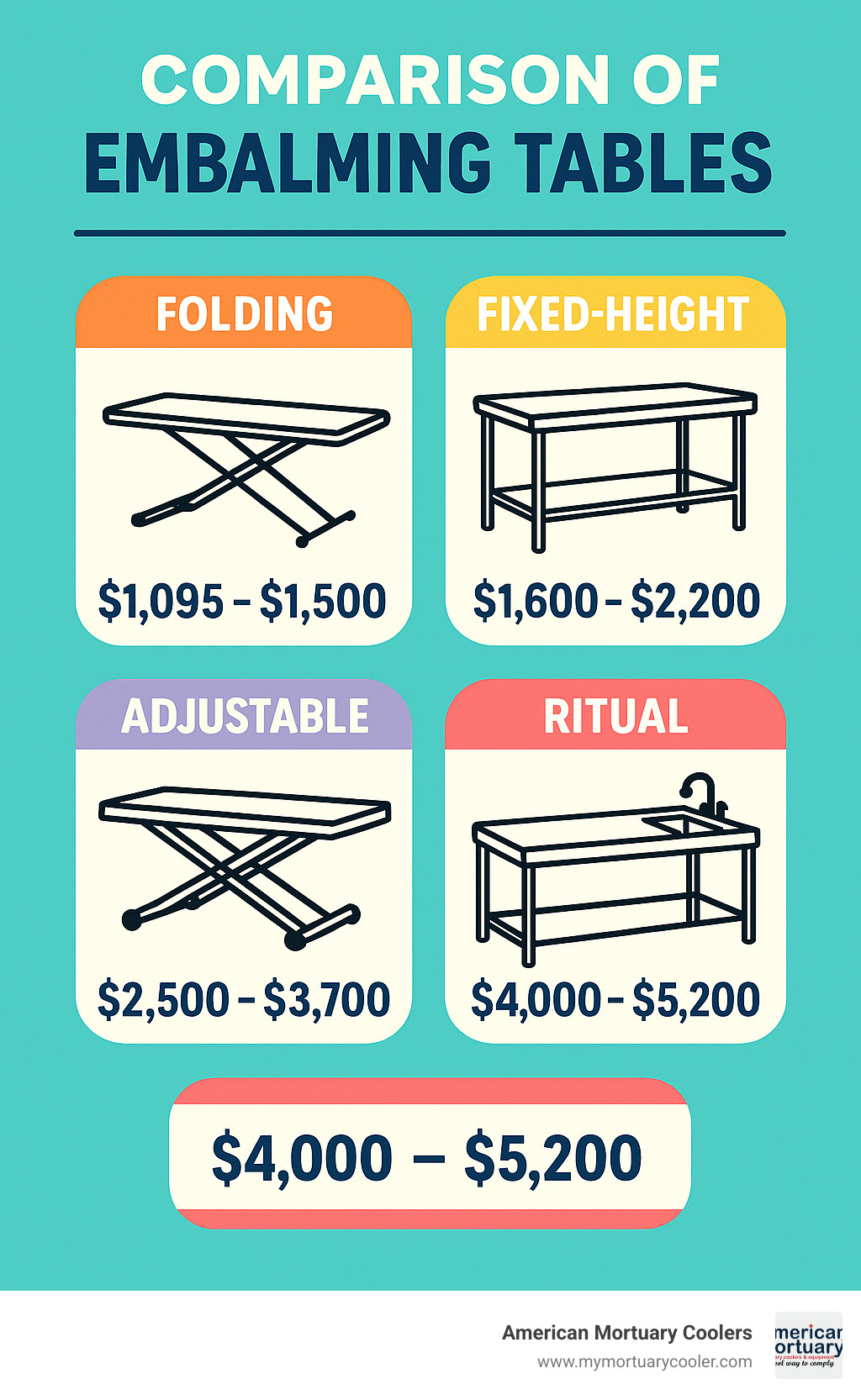
Cost Breakdown by Table Type
When funeral directors call me asking about embalming tables, they're often surprised by the price range. Let me walk you through what you get at each level:
Entry-Level (Folding Tables): $1,095 - $1,500 These are your basic workhorses—simple, functional, and perfect for smaller facilities or as backup tables. While they don't offer height adjustment, they're incredibly practical for facilities with inconsistent case volumes or limited space. One of our Kentucky customers keeps two folding tables in storage for those occasional busy periods, saying it's "the best insurance policy we've ever bought."
Mid-Range (Standard Fixed & Multi-Height): $1,800 - $3,000 Here's where you start getting solid, everyday performers. These tables offer better construction quality and some adjustability features. They're the sweet spot for many small to medium funeral homes, providing reliable service without breaking the bank. As one of our Tennessee funeral directors put it, "It's the Toyota Camry of embalming tables—not flashy, but it'll run forever with basic maintenance."
Premium (Hydraulic & Specialized): $3,000 - $5,194 The Mercedes-Benz of embalming tables. Full hydraulic height adjustment, superior drainage systems, and thoughtful ergonomic features make these worth every penny for busy establishments. A funeral director from Seattle told me, "We calculated that our hydraulic table would pay for itself in three years just by reducing staff fatigue and overtime. It ended up doing it in two."
Top Manufacturers & Innovations
The embalming table market has several standout brands, each with their own strengths:
Ferno has built a reputation for rock-solid reliability. Their Model 101-H Hydraulic and Model 102 Folding tables have become industry standards that many funeral directors compare all others against. They're like the comfortable old boots of the industry—perhaps not the most exciting, but you know exactly what you're getting.
Mobi Medical Supply excels in versatility, offering everything from basic folding tables to sophisticated hydraulic systems. They've been particularly responsive to customer feedback, regularly updating their designs based on what funeral directors actually need.
Mortech has carved out a niche with their integrated ventilation systems. Their Model 600035 Ventilated Embalming Table with side perforated exhaust connections is particularly popular in metropolitan areas where air quality regulations are stricter.
Recent innovations have made modern embalming tables almost unrecognizable compared to models from just 20 years ago. Perforated downdraft surfaces now significantly improve air quality in the prep room. Electric immersion systems make specialized preparations more efficient. Some premium models even include integrated scales for accurate weight measurement—a feature that's particularly valuable when calculating embalming fluid requirements.
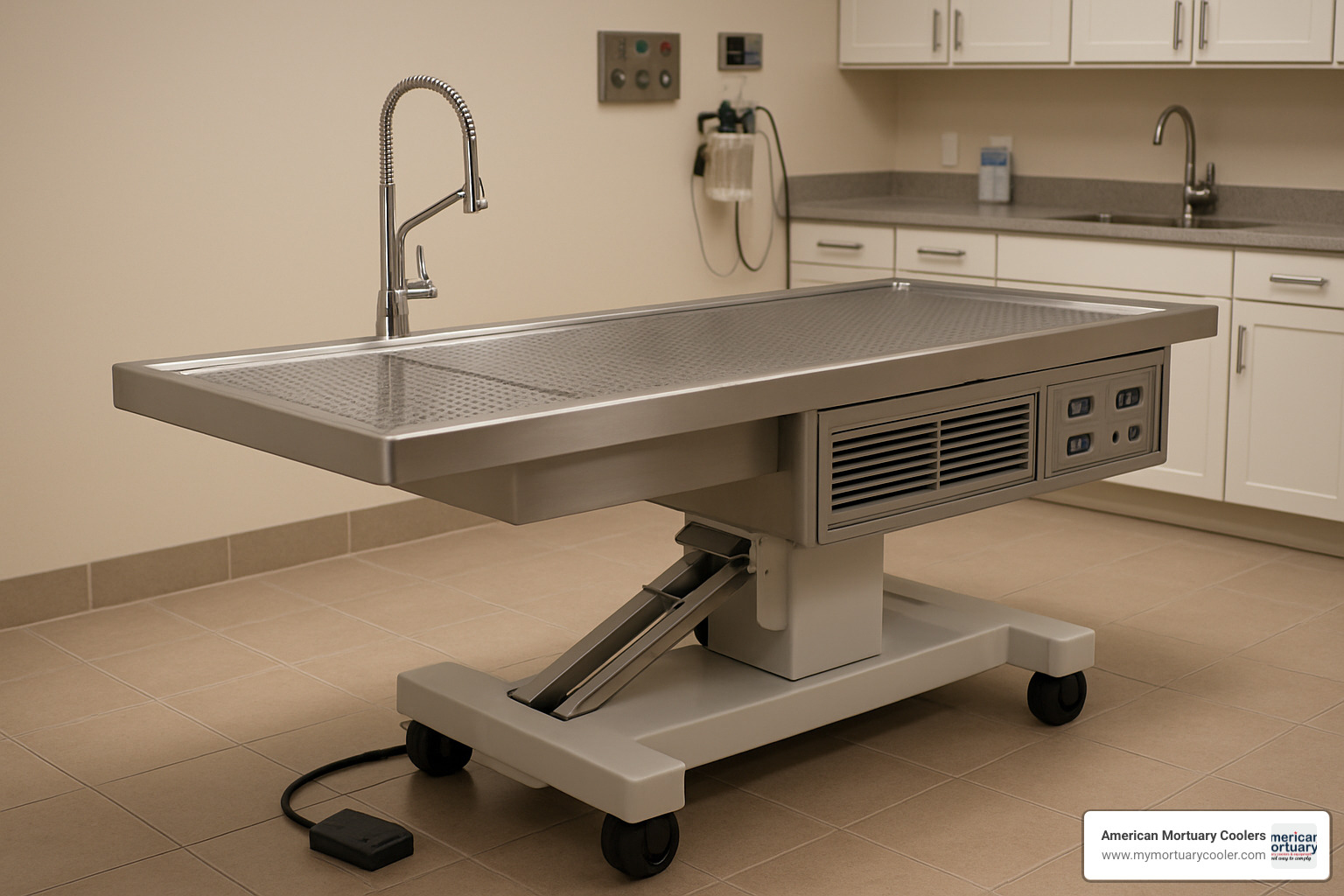
Step-by-Step Buying Checklist
After helping hundreds of funeral homes select the right embalming table, I've developed this practical checklist to guide your decision:
First, consider your facility size and layout. I once delivered a beautiful hydraulic table to a funeral home in Virginia, only to find it wouldn't fit through their prep room door. Measure everything—room dimensions, doorway widths, and even ceiling height if you're considering ventilation systems. One inch can make all the difference!
Next, honestly assess your case volume and type. A small rural funeral home handling 50 cases annually has very different needs than an urban establishment serving 300+ families each year. Do you frequently serve larger individuals? A bariatric table might be essential rather than optional. Do you perform specialized preparations? Ventilation features might be worth the investment.
Don't overlook staff considerations. If you have embalmers of varying heights, an adjustable table can prevent back strain and improve work quality. I recently spoke with a funeral director in Ohio who said, "Getting our hydraulic table was like giving everyone a raise—nobody dreads prep room duty anymore."
Think about your budget and future growth. A quality embalming table typically lasts 10-15 years, so consider where your business will be down the road. Will you be handling more cases? Offering new services? The most expensive mistake I see is funeral homes outgrowing their equipment within a few years of purchase.
Finally, don't forget installation and maintenance requirements. Some tables need specific drainage configurations or electrical connections. Before you buy, make sure your facility can support your chosen table, or budget for necessary modifications.
At American Mortuary Coolers, we've helped funeral homes across all 48 contiguous states steer these decisions. From our home base in Tennessee to California, New York, and everywhere in between, we understand the regional differences that might affect your choice of embalming table.
More info about high-quality embalming tables
Frequently Asked Questions about Embalming Tables
What is the standard size and capacity of an embalming table?
When funeral directors ask me about sizing, I tell them that standard embalming tables typically measure 32"×80", which accommodates most individuals comfortably. For facilities needing more robust options, larger models measuring 35"×85" are available.
As for weight capacity, standard tables handle between 600-650 pounds, while specialized bariatric models support up to 1,000 pounds. Every proper table includes that critical 3-inch built-in slope that makes all the difference in fluid management.
Through our installations from Tennessee to California, I've noticed an interesting trend - about 20% of funeral homes in our Midwest Region now include at least one bariatric-capable table. This reflects the changing needs of the communities they serve, and it's something worth considering when planning your preparation room.
How often should the drainage system be cleaned?
Drainage maintenance is something I'm passionate about because it affects both sanitation and equipment longevity. Your embalming table drainage system deserves attention after every case - a quick flush prevents buildup of tissue, hair, and chemical residues that can create bigger problems down the road.
Daily cleaning with appropriate disinfectants should be standard practice, with special focus on the drain stem and connections where residue tends to accumulate. I also recommend a quarterly deep clean where you actually remove and inspect drain components for wear or damage.
One of our preparation room managers in Johnson City, Tennessee shared a brilliant approach that I now recommend to everyone: "We use a scheduled maintenance log that tracks daily, weekly, and monthly cleaning tasks. This systematic approach has virtually eliminated drainage issues." Simple but remarkably effective!
Can the same table be used for dressing and autopsy?
This is one of the most common questions I hear from funeral homes trying to maximize their equipment investment. Yes, many embalming tables can serve double-duty for both dressing and autopsy procedures, but there are important considerations.
Combination tables with proper drainage and easily cleanable surfaces can handle both functions, but you'll need thorough sanitization protocols when transitioning between uses. For facilities regularly performing autopsies, I typically suggest dedicated autopsy tables with specialized features like improved drainage channels, perforated surfaces, and integrated ventilation connections.
A funeral director from our Chicago service area shared some practical wisdom that resonated with me: "We use our hydraulic embalming table for both standard preparations and occasional autopsies, but we've developed a specific sanitization protocol that goes beyond our standard cleaning when transitioning between these different uses."
For smaller funeral homes or those with space constraints, a high-quality combination table with stringent cleaning practices can be a sensible compromise that saves both space and budget without compromising standards.
Conclusion
Choosing the right embalming table is truly one of the most important decisions a funeral professional will make. It's not just a piece of equipment—it's the foundation of your preparation room that affects your daily operations, your staff's physical wellbeing, and ultimately the quality of care you provide families.
Throughout this guide, we've explored everything from basic folding tables to sophisticated hydraulic systems, helping you understand how each option might fit your unique situation. As someone who's worked with funeral homes of all sizes across the country, I've seen how the right table can transform a preparation room's efficiency.
At American Mortuary Coolers, we take pride in helping funeral professionals find perfect solutions custom to their specific needs. Our Tennessee-based team serves funeral homes nationwide—from busy urban establishments in New York and Chicago to family-owned rural funeral homes in the heartland. We understand that every preparation room is different, just as every funeral home serves a unique community with specific needs.
I've personally helped funeral directors who were overwhelmed by options narrow down their choices based on their facility size, case volume, and budget constraints. There's something deeply satisfying about seeing a preparation room transform with equipment that truly fits the space and workflow. One director in Memphis told me, "I never realized how much time we were wasting with our old table until we upgraded. Now our preps are more efficient, and my embalmer's back pain has practically disappeared."
Whether you're opening a new funeral home, renovating an existing preparation room, or simply replacing aging equipment, we're here to guide you through the process. Our nationwide delivery service reaches all 48 contiguous states, and we provide detailed installation guidance to ensure your new embalming table is set up correctly from day one.
The table you select today will likely serve your establishment for the next decade or more. It's worth taking the time to consider all the factors we've discussed—from material construction and drainage systems to ergonomics and specialized features—to ensure you're making an investment that will stand the test of time.
We'd love to help you find the perfect embalming table for your funeral home. Our team is just a phone call away, ready to provide personalized recommendations based on your specific situation and needs. After all, the foundation of exceptional care begins with the right equipment.
More info about embalming, dressing, and transport equipment


















